Waves That Move the Medium Parallel to the Direction the Wave Is Traveling
xvi Waves
16.i Traveling Waves
Learning Objectives
By the finish of this section, you will be able to:
- Depict the basic characteristics of wave move
- Define the terms wavelength, amplitude, period, frequency, and moving ridge speed
- Explicate the difference between longitudinal and transverse waves, and give examples of each type
- Listing the different types of waves
We saw in Oscillations that oscillatory move is an important type of behavior that can be used to model a broad range of physical phenomena. Oscillatory motion is as well important considering oscillations can generate waves, which are of cardinal importance in physics. Many of the terms and equations we studied in the chapter on oscillations apply equally well to wave motion (Figure).
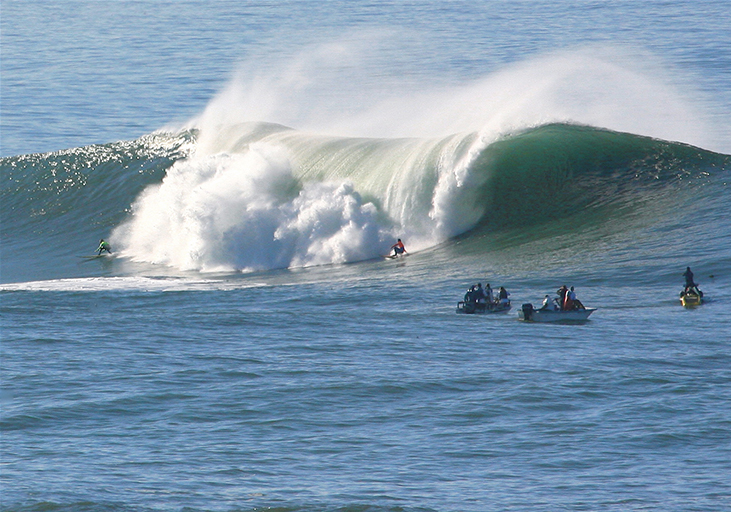
An ocean wave is probably the commencement picture that comes to heed when you hear the give-and-take "wave." Although this breaking wave, and sea waves in general, take apparent similarities to the basic moving ridge characteristics we will discuss, the mechanisms driving bounding main waves are highly complex and beyond the scope of this chapter. Information technology may seem natural, and fifty-fifty advantageous, to apply the concepts in this affiliate to ocean waves, but ocean waves are nonlinear, and the simple models presented in this chapter do not fully explicate them. (credit: Steve Jurvetson)
Types of Waves
A wave is a disturbance that propagates, or moves from the place information technology was created. There are 3 basic types of waves: mechanical waves, electromagnetic waves, and thing waves.
Basic mechanical waves are governed by Newton'south laws and require a medium. A medium is the substance a mechanical waves propagates through, and the medium produces an elastic restoring force when information technology is deformed. Mechanical waves transfer free energy and momentum, without transferring mass. Some examples of mechanical waves are water waves, audio waves, and seismic waves. The medium for water waves is water; for sound waves, the medium is ordinarily air. (Sound waves can travel in other media equally well; we will look at that in more detail in Sound.) For surface water waves, the disturbance occurs on the surface of the water, perhaps created by a rock thrown into a pond or past a swimmer splashing the surface repeatedly. For sound waves, the disturbance is a change in air pressure level, perhaps created by the oscillating cone within a speaker or a vibrating tuning fork. In both cases, the disturbance is the oscillation of the molecules of the fluid. In mechanical waves, energy and momentum transfer with the motion of the wave, whereas the mass oscillates around an equilibrium indicate. (We talk over this in Energy and Power of a Wave.) Earthquakes generate seismic waves from several types of disturbances, including the disturbance of Earth'south surface and pressure level disturbances under the surface. Seismic waves travel through the solids and liquids that form Earth. In this chapter, we focus on mechanical waves.
Electromagnetic waves are associated with oscillations in electric and magnetic fields and do non require a medium. Examples include gamma rays, X-rays, ultraviolet waves, visible light, infrared waves, microwaves, and radio waves. Electromagnetic waves can travel through a vacuum at the speed of light, [latex]v=c=two.99792458\times {10}^{viii}\,\text{g/south}.[/latex] For example, light from distant stars travels through the vacuum of space and reaches Earth. Electromagnetic waves have some characteristics that are similar to mechanical waves; they are covered in more particular in Electromagnetic Waves in volume 2 of this text.
Affair waves are a central part of the branch of physics known equally quantum mechanics. These waves are associated with protons, electrons, neutrons, and other fundamental particles found in nature. The theory that all types of matter have moving ridge-like properties was offset proposed past Louis de Broglie in 1924. Matter waves are discussed in Photons and Affair Waves in the tertiary volume of this text.
Mechanical Waves
Mechanical waves showroom characteristics common to all waves, such as aamplitude, wavelength, period, frequency, and energy. All wave characteristics tin be described by a small-scale set of underlying principles.
The simplest mechanical waves echo themselves for several cycles and are associated with simple harmonic motility. These simple harmonic waves can be modeled using some combination of sine and cosine functions. For instance, consider the simplified surface water moving ridge that moves beyond the surface of h2o every bit illustrated in Effigy. Different circuitous bounding main waves, in surface water waves, the medium, in this case water, moves vertically, oscillating up and down, whereas the disturbance of the wave moves horizontally through the medium. In Figure, the waves causes a seagull to move up and downwards in simple harmonic motion as the moving ridge crests and troughs (peaks and valleys) pass under the bird. The crest is the highest point of the moving ridge, and the trough is the lowest role of the wave. The time for one complete oscillation of the upward-and-down motion is the wave'due south period T. The wave's frequency is the number of waves that pass through a signal per unit time and is equal to [latex]f=ane\text{/}T.[/latex] The period can be expressed using any user-friendly unit of measurement of fourth dimension but is usually measured in seconds; frequency is normally measured in hertz (Hz), where [latex]1\,{\text{Hz}=1\,\text{southward}}^{-one}.[/latex]
The length of the wave is called the wavelength and is represented by the Greek letter lambda [latex](\lambda )[/latex], which is measured in any convenient unit of length, such as a centimeter or meter. The wavelength can be measured between any two like points along the medium that accept the same superlative and the aforementioned slope. In Figure, the wavelength is shown measured between two crests. As stated in a higher place, the period of the wave is equal to the time for one oscillation, but information technology is also equal to the time for one wavelength to laissez passer through a indicate along the moving ridge's path.
The amplitude of the moving ridge (A) is a measure out of the maximum displacement of the medium from its equilibrium position. In the figure, the equilibrium position is indicated by the dotted line, which is the height of the water if there were no waves moving through it. In this instance, the wave is symmetrical, the crest of the wave is a distance [latex]\text{+}A[/latex] in a higher place the equilibrium position, and the trough is a distance [latex]\text{−}A[/latex] below the equilibrium position. The units for the amplitude can exist centimeters or meters, or any convenient unit of distance.
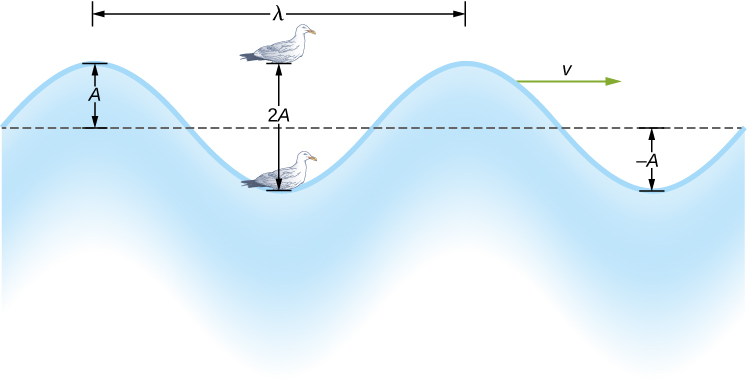
The water wave in the effigy moves through the medium with a propagation velocity [latex]\mathbf{\overset{\to }{v}}.[/latex] The magnitude of the moving ridge velocity is the distance the wave travels in a given time, which is one wavelength in the time of ane period, and the wave speed is the magnitude of moving ridge velocity. In equation form, this is
[latex]5=\frac{\lambda }{T}=\lambda f.[/latex]
This cardinal relationship holds for all types of waves. For water waves, v is the speed of a surface moving ridge; for audio, five is the speed of sound; and for visible light, v is the speed of light.
Transverse and Longitudinal Waves
We have seen that a simple mechanical moving ridge consists of a periodic disturbance that propagates from one place to another through a medium. In Effigy(a), the wave propagates in the horizontal direction, whereas the medium is disturbed in the vertical direction. Such a wave is called a transverse wave. In a transverse moving ridge, the moving ridge may propagate in any direction, but the disturbance of the medium is perpendicular to the direction of propagation. In contrast, in a longitudinal moving ridge or compressional wave, the disturbance is parallel to the direction of propagation. Effigy(b) shows an example of a longitudinal moving ridge. The size of the disturbance is its amplitude A and is completely independent of the speed of propagation v.

A unproblematic graphical representation of a section of the jump shown in Figure(b) is shown in Figure. Figure(a) shows the equilibrium position of the spring before whatsoever waves move downwards it. A point on the spring is marked with a blue dot. Figure(b) through (g) evidence snapshots of the spring taken one-quarter of a period apart, old after the stop of` the spring is oscillated dorsum and along in the 10-direction at a constant frequency. The disturbance of the wave is seen every bit the compressions and the expansions of the jump. Note that the blue dot oscillates effectually its equilibrium position a distance A, equally the longitudinal wave moves in the positive 10-direction with a constant speed. The altitude A is the aamplitude of the wave. The y-position of the dot does non change equally the wave moves through the bound. The wavelength of the wave is measured in part (d). The wavelength depends on the speed of the moving ridge and the frequency of the driving force.
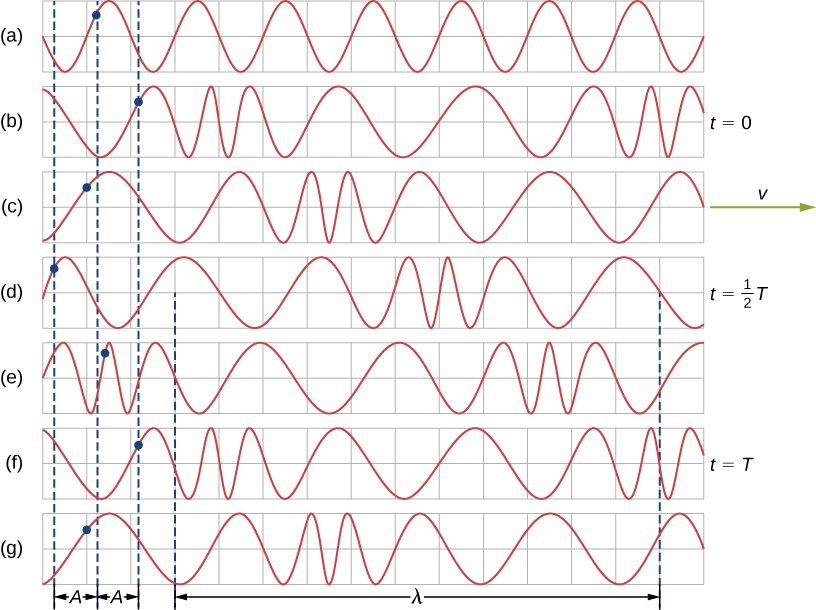
Waves may be transverse, longitudinal, or a combination of the two. Examples of transverse waves are the waves on stringed instruments or surface waves on water, such as ripples moving on a pond. Sound waves in air and water are longitudinal. With audio waves, the disturbances are periodic variations in force per unit area that are transmitted in fluids. Fluids do not take observable shear strength, and for this reason, the audio waves in them are longitudinal waves. Sound in solids can have both longitudinal and transverse components, such as those in a seismic moving ridge. Earthquakes generate seismic waves under Earth'south surface with both longitudinal and transverse components (called compressional or P-waves and shear or S-waves, respectively). The components of seismic waves have important private characteristics—they propagate at different speeds, for example. Earthquakes also have surface waves that are similar to surface waves on h2o. Body of water waves also have both transverse and longitudinal components.
Example
Moving ridge on a String
A student takes a thirty.00-m-long string and attaches one end to the wall in the physics lab. The pupil then holds the complimentary end of the rope, keeping the tension constant in the rope. The student then begins to send waves downward the cord by moving the end of the cord up and downward with a frequency of 2.00 Hz. The maximum displacement of the end of the string is twenty.00 cm. The start wave hits the lab wall 6.00 s subsequently it was created. (a) What is the speed of the moving ridge? (b) What is the flow of the wave? (c) What is the wavelength of the moving ridge?
Strategy
- The speed of the wave tin be derived by dividing the distance traveled by the time.
- The period of the wave is the changed of the frequency of the driving strength.
- The wavelength can exist establish from the speed and the period [latex]v=\lambda \text{/}T.[/latex]
Solution
- The first moving ridge traveled xxx.00 m in 6.00 s:
[latex]v=\frac{30.00\,\text{thou}}{vi.00\,\text{s}}=5.00\frac{\text{m}}{\text{s}}.[/latex]
- The period is equal to the inverse of the frequency:
[latex]T=\frac{1}{f}=\frac{1}{2.00\,{\text{s}}^{-i}}=0.50\,\text{s}.[/latex]
- The wavelength is equal to the velocity times the catamenia:
[latex]\lambda =vT=five.00\frac{\text{one thousand}}{\text{south}}(0.fifty\,\text{s})=ii.50\,\text{g}.[/latex]
Significance
The frequency of the wave produced by an oscillating driving force is equal to the frequency of the driving forcefulness.
Check Your Understanding
When a guitar cord is plucked, the guitar string oscillates every bit a result of waves moving through the cord. The vibrations of the string cause the air molecules to oscillate, forming sound waves. The frequency of the sound waves is equal to the frequency of the vibrating string. Is the wavelength of the sound wave always equal to the wavelength of the waves on the string?
Evidence Solution
The wavelength of the waves depends on the frequency and the velocity of the moving ridge. The frequency of the audio wave is equal to the frequency of the wave on the string. The wavelengths of the sound waves and the waves on the string are equal merely if the velocities of the waves are the aforementioned, which is not ever the instance. If the speed of the sound moving ridge is different from the speed of the wave on the string, the wavelengths are different. This velocity of sound waves will be discussed in Sound.
Example
Characteristics of a Wave
A transverse mechanical wave propagates in the positive x-direction through a spring (as shown in Figure(a)) with a constant wave speed, and the medium oscillates between [latex]\text{+}A[/latex] and [latex]\text{−}A[/latex] effectually an equilibrium position. The graph in Effigy shows the height of the spring (y) versus the position (x), where the x-axis points in the direction of propagation. The figure shows the meridian of the leap versus the x-position at [latex]t=0.00\,\text{s}[/latex] equally a dotted line and the moving ridge at [latex]t=3.00\,\text{s}[/latex] as a solid line. (a) Make up one's mind the wavelength and aamplitude of the wave. (b) Observe the propagation velocity of the moving ridge. (c) Calculate the period and frequency of the wave.
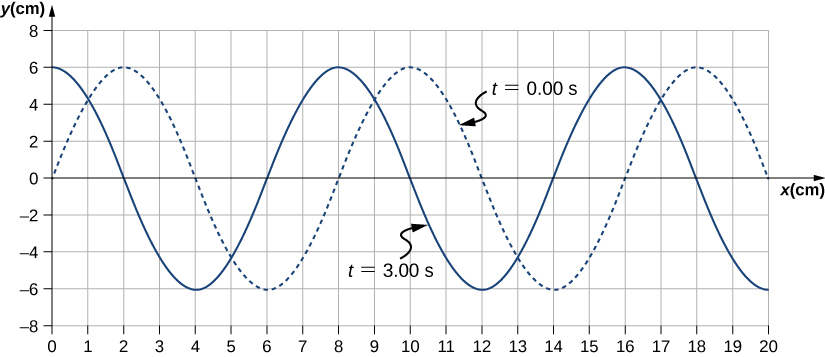
Strategy
- The aamplitude and wavelength can be determined from the graph.
- Since the velocity is constant, the velocity of the wave tin can exist institute past dividing the altitude traveled past the wave by the time it took the wave to travel the distance.
- The period tin can exist establish from [latex]v=\frac{\lambda }{T}[/latex] and the frequency from [latex]f=\frac{i}{T}.[/latex]
Solution
- Read the wavelength from the graph, looking at the purple pointer in Figure. Read the amplitude by looking at the light-green arrow. The wavelength is [latex]\lambda =viii.00\,\text{cm}[/latex] and the amplitude is [latex]A=6.00\,\text{cm}.[/latex]
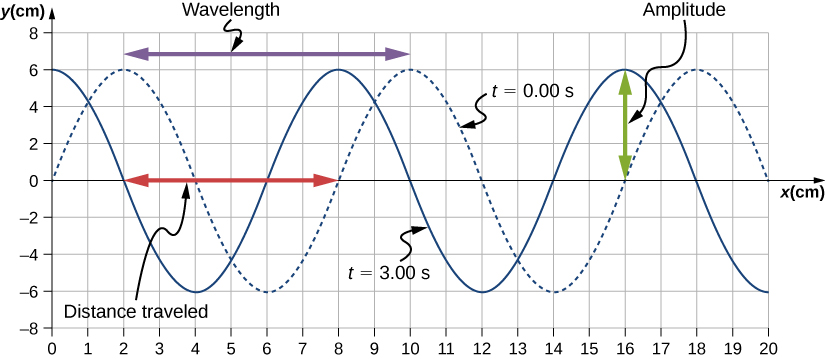
Figure 16.seven Characteristics of the wave marked on a graph of its displacement. - The distance the wave traveled from time [latex]t=0.00\,\text{southward}[/latex] to fourth dimension [latex]t=3.00\,\text{s}[/latex] can be seen in the graph. Consider the ruby arrow, which shows the altitude the crest has moved in 3 southward. The distance is [latex]eight.00\,\text{cm}-2.00\,\text{cm}=half dozen.00\,\text{cm}.[/latex] The velocity is
[latex]five=\frac{\Delta x}{\Delta t}=\frac{eight.00\,\text{cm}-2.00\,\text{cm}}{three.00\,\text{s}-0.00\,\text{south}}=ii.00\,\text{cm/s}.[/latex]
- The period is [latex]T=\frac{\lambda }{v}=\frac{eight.00\,\text{cm}}{ii.00\,\text{cm/southward}}=4.00\,\text{southward}[/latex] and the frequency is [latex]f=\frac{1}{T}=\frac{one}{iv.00\,\text{southward}}=0.25\,\text{Hz}.[/latex]
Significance
Note that the wavelength can be institute using any ii successive identical points that echo, having the aforementioned superlative and slope. Yous should choose 2 points that are virtually user-friendly. The displacement can also be found using any convenient point.
Check Your Understanding
The propagation velocity of a transverse or longitudinal mechanical wave may be constant every bit the wave disturbance moves through the medium. Consider a transverse mechanical moving ridge: Is the velocity of the medium also constant?
Bear witness Solution
In a transverse wave, the wave may move at a constant propagation velocity through the medium, but the medium oscillates perpendicular to the motion of the moving ridge. If the wave moves in the positive x-direction, the medium oscillates up and downwardly in the y-direction. The velocity of the medium is therefore not abiding, but the medium's velocity and acceleration are similar to that of the simple harmonic motion of a mass on a bound.
Summary
- A moving ridge is a disturbance that moves from the point of origin with a wave velocity v.
- A wave has a wavelength [latex]\lambda[/latex], which is the distance between next identical parts of the moving ridge. Moving ridge velocity and wavelength are related to the wave's frequency and flow by [latex]5=\frac{\lambda }{T}=\lambda f.[/latex]
- Mechanical waves are disturbances that move through a medium and are governed by Newton'southward laws.
- Electromagnetic waves are disturbances in the electric and magnetic fields, and exercise not require a medium.
- Thing waves are a primal role of quantum mechanics and are associated with protons, electrons, neutrons, and other fundamental particles found in nature.
- A transverse wave has a disturbance perpendicular to the wave's direction of propagation, whereas a longitudinal moving ridge has a disturbance parallel to its direction of propagation.
Conceptual Questions
Give one example of a transverse moving ridge and one instance of a longitudinal wave, being careful to notation the relative directions of the disturbance and wave propagation in each.
Prove Solution
A wave on a guitar string is an instance of a transverse wave. The disturbance of the string moves perpendicular to the propagation of the wave. The sound produced by the string is a longitudinal moving ridge where the disturbance of the air moves parallel to the propagation of the moving ridge.
A sinusoidal transverse moving ridge has a wavelength of 2.80 m. It takes 0.10 s for a portion of the string at a position x to motion from a maximum position of [latex]y=0.03\,\text{m}[/latex] to the equilibrium position [latex]y=0.[/latex] What are the flow, frequency, and wave speed of the wave?
What is the divergence between propagation speed and the frequency of a mechanical wave? Does ane or both affect wavelength? If and so, how?
Show Solution
Propagation speed is the speed of the wave propagating through the medium. If the wave speed is constant, the speed tin be found by [latex]v=\frac{\lambda }{T}=\lambda f.[/latex] The frequency is the number of wave that pass a indicate per unit fourth dimension. The wavelength is straight proportional to the moving ridge speed and inversely proportional to the frequency.
Consider a stretched spring, such as a slinky. The stretched spring tin support longitudinal waves and transverse waves. How can y'all produce transverse waves on the jump? How can you lot produce longitudinal waves on the spring?
Consider a wave produced on a stretched leap by property ane end and shaking information technology upwardly and downwards. Does the wavelength depend on the distance you move your mitt upward and down?
Show Solution
No, the distance you motion your hand up and down will make up one's mind the aamplitude of the wave. The wavelength will depend on the frequency you movement your hand upward and down, and the speed of the wave through the bound.
A sinusoidal, transverse wave is produced on a stretched spring, having a period T. Each section of the spring moves perpendicular to the direction of propagation of the wave, in uncomplicated harmonic movement with an amplitude A. Does each section oscillate with the same period as the wave or a different menstruation? If the aamplitude of the transverse wave were doubled simply the catamenia stays the aforementioned, would your respond exist the aforementioned?
An electromagnetic moving ridge, such equally light, does non require a medium. Can you call back of an example that would back up this merits?
Evidence Solution
Light from the Dominicus and stars reach Earth through empty space where there is no medium present.
Problems
Storms in the South Pacific can create waves that travel all the way to the California coast, 12,000 km away. How long does information technology take them to travel this distance if they travel at 15.0 g/s?
Waves on a swimming pool propagate at 0.75 m/s. You splash the water at one finish of the pool and detect the wave go to the opposite end, reflect, and return in 30.00 due south. How far away is the other end of the pool?
Bear witness Solution
[latex]2d=vt\Rightarrow d=11.25\,\text{m}[/latex]
Wind gusts create ripples on the ocean that take a wavelength of 5.00 cm and propagate at two.00 thou/s. What is their frequency?
How many times a minute does a boat bob upward and down on body of water waves that have a wavelength of 40.0 m and a propagation speed of 5.00 m/southward?
Show Solution
[latex]\begin{array}{ccc}\hfill five& =\hfill & f\lambda ,\,\text{so that}\,f=0.125\,\text{Hz, so that}\hfill \\ \hfill Northward& =\hfill & 7.50\,\text{times}\hfill \stop{assortment}[/latex]
Scouts at a camp milk shake the rope span they have merely crossed and detect the wave crests to be viii.00 m apart. If they shake the bridge twice per second, what is the propagation speed of the waves?
What is the wavelength of the waves you create in a swimming pool if you splash your hand at a rate of 2.00 Hz and the waves propagate at a moving ridge speed of 0.800 m/s?
Show Solution
[latex]v=f\lambda \Rightarrow \lambda =0.400\,\text{m}[/latex]
What is the wavelength of an convulsion that shakes yous with a frequency of 10.0 Hz and gets to another city 84.0 km away in 12.0 due south?
Radio waves transmitted through empty space at the speed of lite [latex](v=c=3.00\times {10}^{8}\,\text{thou/s})[/latex] past the Voyager spacecraft have a wavelength of 0.120 m. What is their frequency?
Evidence Solution
[latex]v=f\lambda \Rightarrow f=2.l\times {x}^{9}\,\text{Hz}[/latex]
Your ear is capable of differentiating sounds that make it at each ear just 0.34 ms apart, which is useful in determining where depression frequency audio is originating from. (a) Suppose a low-frequency sound source is placed to the right of a person, whose ears are approximately xviii cm autonomously, and the speed of audio generated is 340 1000/southward. How long is the interval between when the sound arrives at the right ear and the sound arrives at the left ear? (b) Assume the same person was scuba diving and a low-frequency sound source was to the right of the scuba diver. How long is the interval betwixt when the sound arrives at the right ear and the sound arrives at the left ear, if the speed of sound in water is 1500 m/due south? (c) What is significant about the time interval of the two situations?
(a) Seismographs measure the arrival times of earthquakes with a precision of 0.100 s. To get the distance to the epicenter of the quake, geologists compare the inflow times of S- and P-waves, which travel at different speeds. If S- and P-waves travel at 4.00 and 7.twenty km/s, respectively, in the region considered, how precisely can the distance to the source of the convulsion exist determined? (b) Seismic waves from surreptitious detonations of nuclear bombs can be used to locate the test site and detect violations of exam bans. Discuss whether your answer to (a) implies a serious limit to such detection. (Notation also that the doubt is greater if there is an dubiety in the propagation speeds of the S- and P-waves.)
Show Solution
a. The P-waves outrun the Due south-waves by a speed of [latex]v=3.20\,\text{km/south;}[/latex] therefore, [latex]\Delta d=0.320\,\text{km}.[/latex] b. Since the uncertainty in the altitude is less than a kilometer, our answer to part (a) does not seem to limit the detection of nuclear flop detonations. However, if the velocities are uncertain, then the doubtfulness in the distance would increase and could and then make it hard to identify the source of the seismic waves.
A Girl Scout is taking a x.00-km hike to earn a merit badge. While on the hike, she sees a cliff some distance abroad. She wishes to estimate the fourth dimension required to walk to the cliff. She knows that the speed of sound is approximately 343 meters per second. She yells and finds that the repeat returns afterward approximately two.00 seconds. If she can hike ane.00 km in ten minutes, how long would it have her to achieve the cliff?
A quality balls engineer at a frying pan visitor is asked to qualify a new line of nonstick-coated frying pans. The blanket needs to be i.00 mm thick. Ane method to test the thickness is for the engineer to choice a percent of the pans manufactured, strip off the coating, and measure the thickness using a micrometer. This method is a destructive testing method. Instead, the engineer decides that every frying pan will exist tested using a nondestructive method. An ultrasonic transducer is used that produces sound waves with a frequency of [latex]f=25\,\text{kHz}.[/latex] The sound waves are sent through the coating and are reflected by the interface between the coating and the metal pan, and the fourth dimension is recorded. The wavelength of the ultrasonic waves in the blanket is 0.076 m. What should be the time recorded if the coating is the correct thickness (1.00 mm)?
Evidence Solution
[latex]\brainstorm{assortment}{ccc}\hfill v& =\hfill & 1900\,\text{one thousand/s}\hfill \\ \hfill \Delta t& =\hfill & i.05\,\mu \,\text{due south}\hfill \end{array}[/latex]
Glossary
- longitudinal wave
- wave in which the disturbance is parallel to the direction of propagation
- mechanical wave
- wave that is governed by Newton's laws and requires a medium
- transverse wave
- wave in which the disturbance is perpendicular to the direction of propagation
- wave
- disturbance that moves from its source and carries energy
- wave velocity
- velocity at which the disturbance moves; likewise chosen the propagation velocity
- wave speed
- magnitude of the moving ridge velocity
- wavelength
- altitude between next identical parts of a moving ridge
0 Response to "Waves That Move the Medium Parallel to the Direction the Wave Is Traveling"
Post a Comment